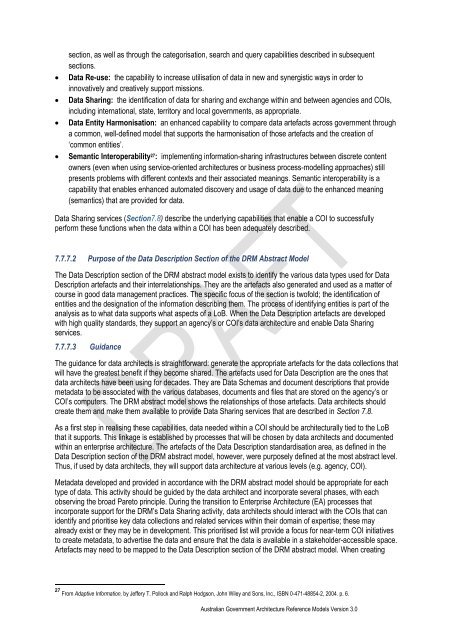Australian Government Architecture Reference Models Version 3.0
Australian Government Architecture Reference Models Version 3.0
Australian Government Architecture Reference Models Version 3.0
You also want an ePaper? Increase the reach of your titles
YUMPU automatically turns print PDFs into web optimized ePapers that Google loves.
section, as well as through the categorisation, search and query capabilities described in subsequent<br />
sections.<br />
� Data Re-use: the capability to increase utilisation of data in new and synergistic ways in order to<br />
innovatively and creatively support missions.<br />
� Data Sharing: the identification of data for sharing and exchange within and between agencies and COIs,<br />
including international, state, territory and local governments, as appropriate.<br />
� Data Entity Harmonisation: an enhanced capability to compare data artefacts across government through<br />
a common, well-defined model that supports the harmonisation of those artefacts and the creation of<br />
‘common entities’.<br />
� Semantic Interoperability 27: implementing information-sharing infrastructures between discrete content<br />
owners (even when using service-oriented architectures or business process-modelling approaches) still<br />
presents problems with different contexts and their associated meanings. Semantic interoperability is a<br />
capability that enables enhanced automated discovery and usage of data due to the enhanced meaning<br />
(semantics) that are provided for data.<br />
Data Sharing services (Section7.8) describe the underlying capabilities that enable a COI to successfully<br />
perform these functions when the data within a COI has been adequately described.<br />
7.7.7.2 Purpose of the Data Description Section of the DRM Abstract Model<br />
The Data Description section of the DRM abstract model exists to identify the various data types used for Data<br />
Description artefacts and their interrelationships. They are the artefacts also generated and used as a matter of<br />
course in good data management practices. The specific focus of the section is twofold; the identification of<br />
entities and the designation of the information describing them. The process of identifying entities is part of the<br />
analysis as to what data supports what aspects of a LoB. When the Data Description artefacts are developed<br />
with high quality standards, they support an agency’s or COI’s data architecture and enable Data Sharing<br />
services.<br />
7.7.7.3 Guidance<br />
The guidance for data architects is straightforward: generate the appropriate artefacts for the data collections that<br />
will have the greatest benefit if they become shared. The artefacts used for Data Description are the ones that<br />
data architects have been using for decades. They are Data Schemas and document descriptions that provide<br />
metadata to be associated with the various databases, documents and files that are stored on the agency’s or<br />
COI’s computers. The DRM abstract model shows the relationships of those artefacts. Data architects should<br />
create them and make them available to provide Data Sharing services that are described in Section 7.8.<br />
As a first step in realising these capabilities, data needed within a COI should be architecturally tied to the LoB<br />
that it supports. This linkage is established by processes that will be chosen by data architects and documented<br />
within an enterprise architecture. The artefacts of the Data Description standardisation area, as defined in the<br />
Data Description section of the DRM abstract model, however, were purposely defined at the most abstract level.<br />
Thus, if used by data architects, they will support data architecture at various levels (e.g. agency, COI).<br />
Metadata developed and provided in accordance with the DRM abstract model should be appropriate for each<br />
type of data. This activity should be guided by the data architect and incorporate several phases, with each<br />
observing the broad Pareto principle. During the transition to Enterprise <strong>Architecture</strong> (EA) processes that<br />
incorporate support for the DRM’s Data Sharing activity, data architects should interact with the COIs that can<br />
identify and prioritise key data collections and related services within their domain of expertise; these may<br />
already exist or they may be in development. This prioritised list will provide a focus for near-term COI initiatives<br />
to create metadata, to advertise the data and ensure that the data is available in a stakeholder-accessible space.<br />
Artefacts may need to be mapped to the Data Description section of the DRM abstract model. When creating<br />
27 From Adaptive Information, by Jeffery T. Pollock and Ralph Hodgson, John Wiley and Sons, Inc., ISBN 0-471-48854-2, 2004. p. 6.<br />
<strong>Australian</strong> <strong>Government</strong> <strong>Architecture</strong> <strong>Reference</strong> <strong>Models</strong> <strong>Version</strong> <strong>3.0</strong><br />
209

















